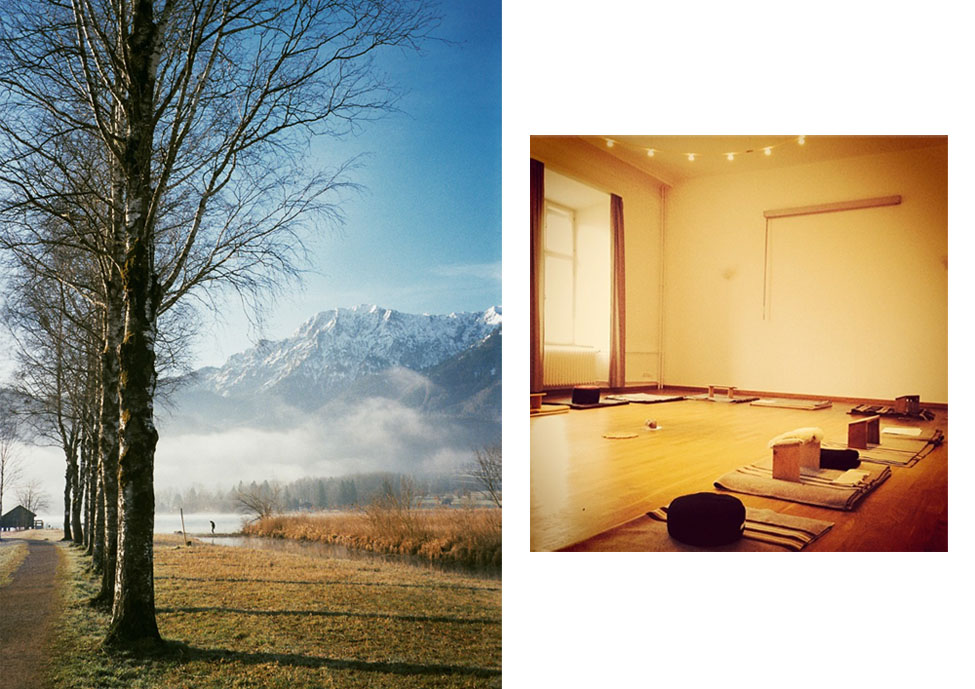
Zen Sesshin Retreat in The Alps
A Time for Silence and Meditation in Nature
PREV
I've been meditating for over ten years and it all started with a book I found in the library of a zen monk explaining what meditation was. The moment of anxiety I was in that moment living started to transform into something else through meditation sessions in my room. It was as if the knot of thoughts in my head started to loose, and mental space appeared again. Since that experience, meditation has become a part of daily my life as brushing my teeth or eat.

Until now, however, I had not had the experience of a Sesshin, where rules are basic: keep silence during the days of the retreat, and make a series of about 10 meditations 25 minutes throughout the day. Sesshin Is a traditional ceremony done in Japanese monasteries where the monks only devote their time to the zazen- sitting meditation- practice-.
Why is so important to be consistent with the seating meditations during the day
The sessions begin at 7 with the first round of meditation, and the program I attended included a couple of yoga exercises´breaks to help alleviate the hours of sitting in the muscles. While the physical part is though, most of the difficult consists on leaving the mind blank for almost all day long. But as the days go by, the mental decompression process, on the thoughts is quite special.
The mind can be trained through meditation and breathing to be more present at the moment and stop wasting energy not living the now.
The days of Sesshin were held in the monastery of Schledorf, in an idyllic location on the outskirts of Munich. Traditionally a Catholic monastery, we as group, were allowed in making our retirement purely based in the zazen practise , with one wing of the monastery adapted to our needs, and practise while sharing the “convent life” during the days the retreat lasted, with the nuns at the monastery.
First experience of sharing daily routines with nuns, and a complete different routine to the rest of the world, hectic, busy, interconnected 24/7.
The Rutines of living in a Convent
That was an unexpected highlight. The second was the stunning nature that surrounded the monastery. . Located at the Lake Kochel, close to the german Alps, having the chance to get lost, in pure silence, and take long walks in nature during the breaks we had spread through the day was so necessary to digest all the thoughts that sort of were taking a different dimension inside.
The nuns were in charge of preparing the food that was served and lunch was eaten in total silence. Our sleeping rooms are the ones the convent has to host their possible guests.
There is no internet or mobile coverage.
A Sesshin retreat is a pause where one does nothing more than get in touch with the self.
The Zen Master Gudrun Zen Alt was responsible for organizing it, and she is a wonderful teacher. An experience that I hope to repeat very soon really necessary in these digital times we live.
I give you the Wikipedia notes so you can also get a nice explanation of the routines step by step:
A sesshin (接心, or also 摂心/攝心 literally “touching the heart-mind“) is a period of intensive meditation (zazen) in a Zen monastery. It is frequently mistranslated in Western Zen centers as “gathering the mind.”
While the daily routine in the monastery requires the monks to meditate several hours a day, during a sesshin they devote themselves almost exclusively to zazen practice. The numerous 30- to 50-minute-long meditation periods are interleaved with short rest breaks, meals, and sometimes short periods of work (Japanese: 作務 samu) all performed with the same mindfulness; nightly sleep is kept to a minimum, at six hours or fewer. During the sesshin period, the meditation practice is occasionally interrupted by the master giving public talks (teisho) and individual direction in private meetings (which may be called dokusan, daisan, or sanzen) with a Zen Master.
In modern Buddhist practice in Japan and the West, sesshins are often attended by lay students and are typically one, three, five, or seven days in length.
A typical Sesshin day
A sesshin schedule in the West will typically allow anywhere from nine to fifteen periods of zazen per day, 30–40 minutes each, with ten minute periods of walking meditation (kinhin) between zazen periods. Traditional sesshin is more intensive, with meditations lasting 30–60 minutes each, with the absence of any rest or work breaks and sleep limited to less than five hours a day.
There is no talking during sesshin. Silence is observed so that each student may both concentrate on their experience and not influence those of others.
At the end of the sesshin, there is usually a meal when students are allowed to talk to others for the first time since arriving.


